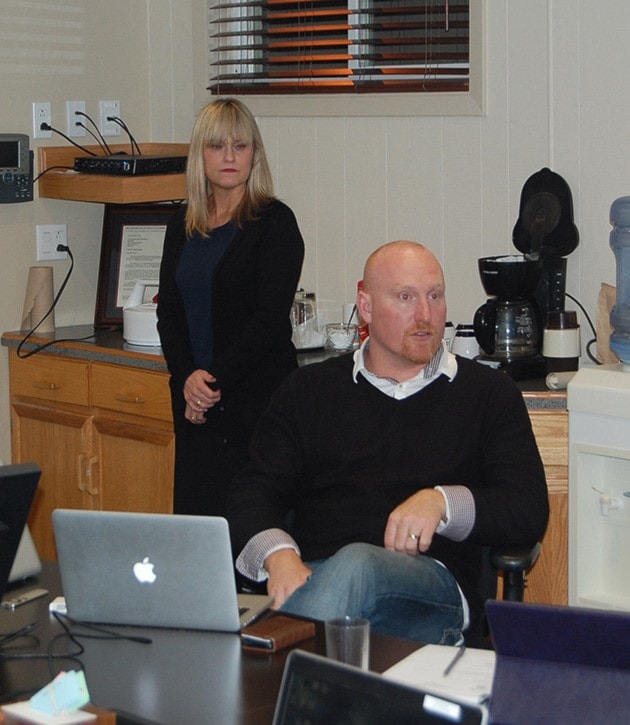iPads at Christina Lake
Mobile devices are becoming more and more prevalent in our society. Tablets such as iPads are being used increasingly in schools to help facilitate learning that involves both teachers and students.
At the School District 51 (SD51) board meeting on Dec. 4 in Grand Forks, Christina Lake Elementary School principal Shawn Lockhart gave a presentation about the iPads his school has been using.
The iPad station, which consists of 30 iPads with chargers and a laptop, were purchased in lieu of having a computer lab, said Lockhart. The school started using the new iPads at the start of this school year.
“Every kid uses it,” he said. “We have the cart in the office and kids come in and sign them out. We usually do it by classroom.”
Lockhart said the school has been using the iPads and various programs and apps to great effect.
“It’s been excellent,” he said. “It’s definitely much more collaborative. It’s more problem-solving based.”
Lockhart told the board about how the Grade 4/5 class taught the Grade 2/3 class how to get on the school’s network and how they worked together to research a project.
He also talked about how music teacher Kristen Nicolson used the iPads and various programs to record the students using recorders and singing.
Clarification on school opening
Trustee Dave Reid proposed a motion, which was carried, asking SD51 superintendent Kevin Argue for clarification on why some schools were closed in the morning before classes. Reid thought that schools should be open when the bus arrives.
“We want the superintendent to look into the differences across the district and the reasoning behind it,” said board chair Teresa Rezansoff. “The board will then have that information and have a further discussion. We’d like to have a discussion with school administrators. We won’t know if we’ll need to go that far until we find out what’s out there.”
One of the concerns brought up by Reid was children left outside in inclement weather.
Board votes
At the inaugural meeting of the board on Dec. 9, the SD51 board of trustees elected Teresa Rezansoff as board chair once again. Cindy Strukoff was elected as vice-chair.
The board welcomed newly elected trustees Mark Danyluk (Area E/Kettle Valley East) and Katie Jepsen (City of Grand Forks).
The meeting with the inauguration of the board as well as the vote for board chair and vice-chair took place before the regular board meeting.
“It was just a funny circumstance here the way the School Board Act reads,” said Rezansoff. “You can’t have your inaugural meeting until after the first Monday of December. A whole bunch of boards got caught on this. We were going to have our first board meeting on the 2nd but we couldn’t.”
The inaugural meeting must take place before the first regular board meeting, said Rezansoff, and, thus, it took place earlier in the day (4 p.m.) on Dec. 9.
Rezansoff is pleased to be back as board chair and is looking forward to a great year with the new board.
“I’m very happy to be back as chair,” she said. “I’m pleased that the trustees have the confidence in me to continue on in the role. We’ve got a four year term ahead of us, we have two new trustees, we have a couple senior staff that are pretty new, they’ve been there a year and a bit, we have lots of potential to move forward.”
Rezansoff added that the board will be looking at a strategic plan for the school district.
“We’re really looking forward to getting out there and having conservations with our communities and our parents.”
Curriculum
During the talking break at the school board meeting on Dec. 9, Doug Lacey, director of learning, gave a presentation on the draft curriculum which looks at changes that transform and modernize the education system throughout B.C. The transformation in curriculum and assessment will help teachers create learning environments that are both engaging and personalized for students.
“For me, from everything I’ve seen and heard about the new draft curriculum, it’s super-exciting,” said Rezansoff. “It opens up learning opportunities in different ways for our students. It’s more open-ending and more flexible for students to get into areas of interest related to those outcomes and what you need to address with the needs of the draft curriculum.”
Rezansoff praised the work of the teachers across the province who have contributed.
“They’ve done an amazing job,” she said. “I know there was a lot of consultation that went into that. Being that it’s just in the draft phase, I know they’ll continue to tweak it. But it’s pretty exciting. We’re leading the world in this curriculum.”
